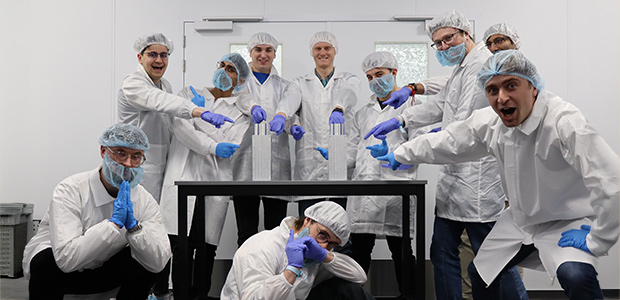
Propelling the space industry forward
As many as 70,000 Low Earth Orbit (LEO) satellites are expected to be launched over the next five years, Goldman Sachs Research has reported, highlighting a growing and thriving industry that has come to rely on satellites for connectivity and observation. Satellites are used for anything from voice communications in remote locations to tracking populations of endangered species.
But satellites are nothing without the launch that gets them up there in the first place. Magdrive, who makes plasma thrusters using solid metal as a propellant, is doing exactly that: creating technology powerful enough to launch satellites into space.
The company was born out of a “series of intense ideation” between Co-Founders Mark Stokes (CEO) and Thomas Clayson (CTO), said James Bass, Head of Mechanical Engineering at Magdrive. Bass is responsible for overseeing the development of the plasma thrusts, watching over the process from early design to flight hardware.
Today, the company has 35 engineers, scientists, and operators on board, funded by a combination of private investment and support from the UK Space Agency (UKSA) and European Space Agency (ESA).
“It’s been a fast ride, but exactly the kind of challenge I was looking for,” noted Bass, who has a background in “hands-on problem solving” that took him from studying aerospace engineering at the University of Manchester, to working on carbon fibre systems at McLaren, and now, having joined in 2020, to Magdrive.
“The concept, quite literally, came to life in a bathtub, where Tom first imagined a compact, high-thrust electric propulsion system that could radically improve in-space manoeuvrability,” explained Bass. “Then in the middle of the Covid lockdowns, what followed was a story of classic startup tenacity: early prototypes built in a spare bedroom, long nights refining the early engineering, and a shared belief that space propulsion could be better, lighter, faster, and far more efficient.
“That early vision laid the groundwork for what’s now become a commercially viable technology and an enthusiastic team driving it forward.”
The result of these hours that were dedicated to planning and engineering was a pulsed plasma thruster that uses solid metal as a propellant, storing and delivering power in short bursts to vaporise and ionise the metal, consequently creating a hot and dense plasma for thrust.
“Mechanically, this poses some unique challenges, including thermal cycling, metal feed reliability, vacuum tolerances, and energy storage integration,” said Bass, adding that it wasn’t “your average propulsion system. We’ve spent years building and testing dozens of prototypes to refine every component.”
Propulsion systems are essential for launching satellites in the first place, but can often be overlooked once deployment has taken place.
“Propulsion systems are key for manoeuvring, collision avoidance, deorbiting, and mission extension,” said Bass, “but the constraints are brutal: mass, volume, power, thermal, cost. Designing propulsion that balances all those factors and still delivers real performance is a far bigger challenge than most people appreciate.”
The capabilities its propulsion system provides are what differentiates it from its competitors, Bass said.
“We provide a magnitude improvement in thrust with a magnitude reduction in volume and mass, meaning we reduce the delivery time from up to 18 months to only a few weeks. That’s what truly sets us apart. The fact that we’ve built our system to be manufacturable and scalable from the outset is another advantage.”
Highlights and what’s next
More recently, Magdrive launched its ‘Going Rogue’ mission on the 23rd June 2025, marking its first in-orbit demonstration. Two of its thrusters, Rogue, were part of the Transporter-14 payload done in partnership with D-Orbit. Rogue is its flagship product.
“That flight was the culmination of five years of deployment,” said Bass. “We’re currently awaiting performance data, which is due to be released in August and September 2025. That flight paves the way for more launches in 2026, as we move toward scaling production and deploying our propulsion systems.”
Although LEO is the company’s core focus – from the perspective of satellite servicing, deorbiting, In-Orbit Servicing and Manufacturing (IOSM), and formation flying – it’s also exploring high-thrust applications such as interplanetary manoeuvres, in-space refuelling, and recycling of orbital debris into propellant.
“We’re thinking long-term,” said Bass.
Key milestones on this journey have included the company being awarded ESA and UKSA funding for R&D; developing its first working prototypes in 2020; building a test facility in the UK known as ‘Disruptive Experimental Electric Propulsion’ or, DEEP, for short; launching the Rogue thruster; and building the team.
Looking forward, analysing data from its Rogue thrusters, launched in June, will provide the startup with a baseline for refining the design of its technology and shaping follow-on missions scheduled for 2026.
“We’re also gearing up for commercial rollout, with the first units expected to be available to satellite operators in 2026,” said Bass. “In parallel, we’re advancing our SuperMagdrive programme, which explores even more powerful pulsed plasma systems. That’s supported by the UK Space Agency’s NISP funding and includes partnerships with OrbitFab and the University of Southampton. It’s a major step towards higher-performance missions and long-term in-space infrastructure.”
In delivering a one-sentence mission statement, Bass said: “Magdrive is powering new possibilities in orbit.” An apt way to describe the company, I’d say.
This article originally appeared in the July/August 2025 issue of Startups Magazine. _Click here to subscribe

